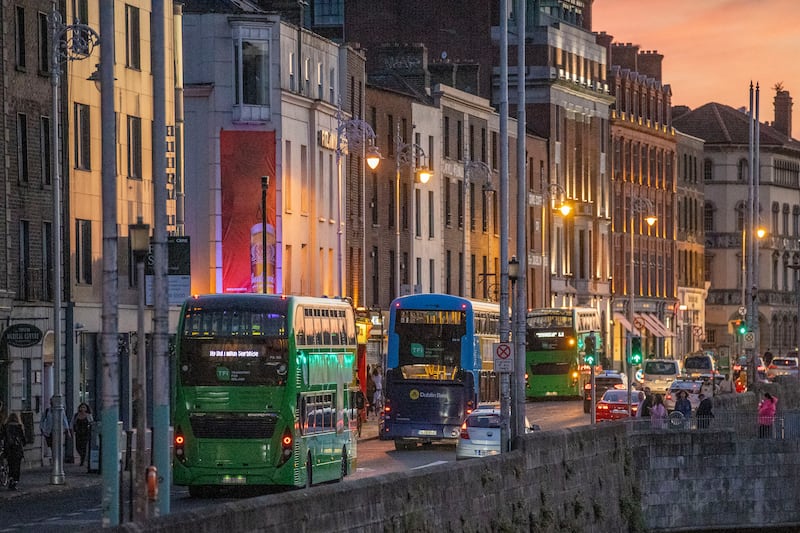Two weeks ago, Paul Gannon set off to get a bus from the South Circular Road in Kilmainham into Dublin city centre to meet some friends and checked Dublin Bus’s real-time app to be told that a 123 would be along shortly.
“There was a torrential downpour that evening,” Gannon says. “I had timed my leaving my apartment so that I would only be waiting a minute or two at the bus stop based off the real-time information. I got to the stop, and the screen said two minutes, then one minute, but it never showed up. I got absolutely drenched as a result.
“I know it’s only a minor inconvenience in the grand scheme of things, but it happens on a fairly regular basis. I get the 123 bus, and I would say one in three will be a phantom bus, as I call them. It’s a regular occurrence.”
“Phantom” or “disappearing” buses are becoming more and more of a problem, say commuters, and TDs have also raised the issue in the Dáil in recent months, in particular in relation to Go-Ahead Ireland bus services.
READ MORE
On-street real-time display screens, as well as mobile apps, say a Dublin Bus or Go-Ahead bus will be along in x amount of minutes only for it to vanish from the screen when the time has elapsed, with no bus in sight.
The Dublin Commuter Coalition wrote to the chairman of the Joint Oireachtas Transport Committee, Fine Gael TD Kieran O’Donnell, just this week saying that for more than a year public transport users have been faced with “long delays, cancelled services, and ‘ghost buses’ and, sadly, the situation is not showing any signs of improving”.
My journey into town should only take about 15 minutes but you have to allow between 45 minutes to an hour, because you just don’t know if the bus is going to turn up
The coalition, alongside its Cork and Galway counterparts, asked that a meeting of the committee be convened to discuss the “crisis point in the Irish public transport system”.
“My journey into town should only take about 15 minutes but you have to allow between 45 minutes to an hour to get into the city centre because you just don’t know if the bus is going to turn up and you’ll have to wait for another,” Gannon adds.
“I was going to the Christmas market with my girlfriend in Dublin Castle last year and we were booked in for a particular time. This time three buses in a row which were on the real-time screen didn’t show, and we were standing at the bus stop for 35 to 40 minutes. It put us under real time pressure to make the booking.”
Each bus operator has its own automatic vehicle location system that is ‘constantly monitoring the bus’s progress along its route and generating a prediction for when buses will arrive at each stop’
There are three primary real-time passenger information outlets – the on-street displays, the Transport for Ireland (TFI) app and the Dublin Bus app.
The National Transport Authority, or NTA, manages both the on-street displays and the TFI app, while Dublin Bus oversees its own app.
The NTA says complaints were received in the past number of weeks relating to “inaccurate information presentations” on on-street displays and that the issue appeared to be “random and intermittent and was thus difficult to diagnose”.
The on-street displays use both scheduled data as well as real-time data of actual positions of the buses. Each bus operator has its own automatic vehicle location, or AVL, system that is “constantly monitoring the bus’s progress along its route, using prediction algorithms to look at the scheduled timings for the buses and the actual position of the buses on their routes, generating a prediction for when buses will arrive at each stop”.
The AVL systems provide such data to the on-street displays.
In light of the complaints, the NTA commissioned on-street video surveys at selected stops to assist in identifying “the root cause of the issue so that log files could be isolated and patterns identified”.
“On Tuesday, October 25th, a fix was implemented in the display’s back office which has now been confirmed as being successful. This will significantly improve the accuracy of the data displayed,” an NTA spokeswoman said.
“The system of real-time passenger information is complex, especially with each operator managing and operating their own AVL systems.”

Dublin Bus said it had been experiencing “technical issues” with its app and on-street display units but it was “confident these are now being successfully addressed”.
It said these issues had also coincided with a shortfall in driver numbers post-Covid, “which is a significant, industry-wide issue”.
“This is despite very active and ongoing recruitment efforts by the company,” Dublin Bus said. “This shortfall has meant Dublin Bus has failed to operate a small percentage of scheduled journeys.”
Go-Ahead, which operates a number of Dublin city bus routes, having taken them over from Dublin Bus in 2018, said the NTA “develops and manages all aspects of the real-time passenger information” and had nothing further to add.
Dermot O’Leary, general secretary of the National Bus and Rail Union (NBRU), says recent disruptions to Dublin Bus services are “absolutely” related to a shortage of drivers.
“There was obviously no recruitment during Covid with the travel restrictions and reduced services and that,” he says. “After Covid, there was a downscaled version of Dublin Bus’s training school [for drivers] brought back and it takes six weeks to train a driver. Unfortunately not all of those pass the driving test at the end.
“The other thing that’s been thrown into the mix is BusConnects, which has been rolled out on a staggered basis since last year, and there’s the requirement now for a significant number of drivers as a result of that.”
The BusConnects programme, which plans to overhaul the bus system in Dublin, has two main components: creating 230km of dedicated bus lanes in tandem with 200km of cycle tracks, and redesigning the bus network.
The aim of the project is to increase the level of bus services in Dublin by 23 per cent and provide a more coherent service that will eliminate overlapping routes and improve journey times.
O’Leary also says bus operators are facing difficulties with the retention of staff because of antisocial behaviour and a lack of adequate toilet facilities.
“These are two of the biggest issues in terms of retention at the moment. Drivers won’t stay in a job where the services and infrastructure are not available to them; getting threatened, attacked or abused as well as having no toilet facilities is just not on,” he adds.
Odran Reid, from Glasnevin, commutes into the city centre at least four days a week, though he usually walks a chunk of the route to save himself from being stranded at a bus stop.
Reid says that while real-time information has “deteriorated” over the last two years, it has become “particularly awful over the last few months”.
“It can be so frustrating; you’re walking in between stops and a bus that’s not supposed to arrive appears and you end up missing it,” he says.
It’s like years ago, you’re sitting at a stop and you don’t know if you should stay or go. In terms of real-time, it’s not real-time
“Then a bus that is due disappears. [The screen] says two minutes [away], one minute and then it vanishes. I’ve seen multiple buses in a row that never show. I get the bus most days... and it would happen probably two or three times a week.
“It’s like years ago, you’re sitting at a stop and you don’t know if you should stay or go. In terms of real-time, it’s not real-time. One or two minutes [away] is actually four or five minutes when a bus actually does come. Real-time in other countries is much more efficient and comes within seconds.”
Sinn Féin TD Réada Cronin told the Dáil last month that she knew of several workers who were “on late warnings from their employer and one on a final late warning” because of the unreliability of the 120 bus, which Go-Ahead operates between Edenderry and UCD.
Her party colleague Louise O’Reilly says there has been an “uptick” in the number of parents contacting her constituency office in Dublin Fingal about problems with the 33B bus, which runs between Portrane and Swords.
“I’ve had contacts from parents who are concerned about their kids, because particularly if you’re a working parent, it gets dark at five o’clock now and you want to know that the kids are going to be able to come home,” she says.
“I had a few parents contact me in particular in relation to the 33B, which failed to show one afternoon. That’s a real worry for parents... It’s the only bus that serves the route.”
[ Mark Paul: Dublin Bus customers should go on strike tooOpens in new window ]
Orlagh McGarry from Shankill says her 12-year-old son, who has “severe dyslexia”, is “constantly” left waiting for the 45A, which drops him to school in Bray.
“He only started secondary school in September and the bus would be relatively new to him,” she says. “The stop is only across the road but two out of the five days the 8am bus doesn’t show.
“He usually ends up getting another bus and then will have to walk about 20 minutes. Because of his dyslexia, everything has to be planned out, and the bus not showing up is a real added stress for him.
“When things don’t go to plan, it really affects him. He’s only eight weeks into secondary school and already it’s a problem. One day he was waiting on the 45A to get to swimming and it was supposed to be coming but never arrived. The next one wasn’t due for 45 minutes. Luckily my husband was home and could drop him.”
Dr Brian Caulfield, associate professor and head of discipline in the Department of Civil, Structural and Environmental Engineering at Trinity College Dublin, says the reason real-time information is used is to give people more confidence in accessing public transport and that it must be “more accurate”.
For public transport to compete with the car, it needs to be as reliable as possible and the information needs to be as good as possible
Caulfield says there was a “bounce” in bus usage when real-time information screens were first rolled out at selected stops in February 2011.
“I think for bus services that are really frequent like the 46A or the 16, buses disappearing off the screen may not have that big of an impact. It’s the services that are less common, like the 11 or 17, where you’re really relying on it and you don’t have another backup for another half an hour, so that could then push people into using alternative modes,” he says.
“The bigger issue is that by the end of the decade we want to have an extra half a million trips by walking, cycling and public transport. For public transport to compete with the car, it needs to be as reliable as possible and the information needs to be as good as possible... Vanishing buses will mean vanishing passengers. People will vote with their feet and if it’s not reliable, they’re not going to pick it.”
The NTA says it is in the process of procuring a single national bus AVL system that will be used by all non-commercial bus operators that will “simplify the interfaces to the real time platforms and will result in improved data quality”. The procurement for this new national system has entered the negotiation phase, with a contract scheduled to be awarded in 2023, it said. “The roll-out of this solution across all of the national bus fleet is expected to take about 18 months.”




















